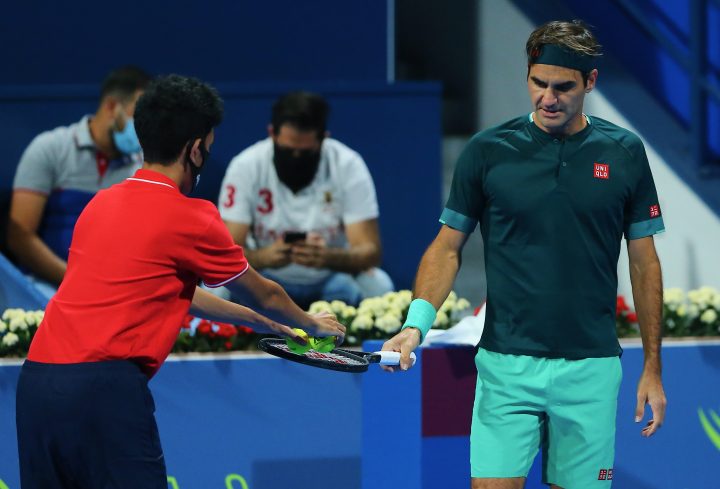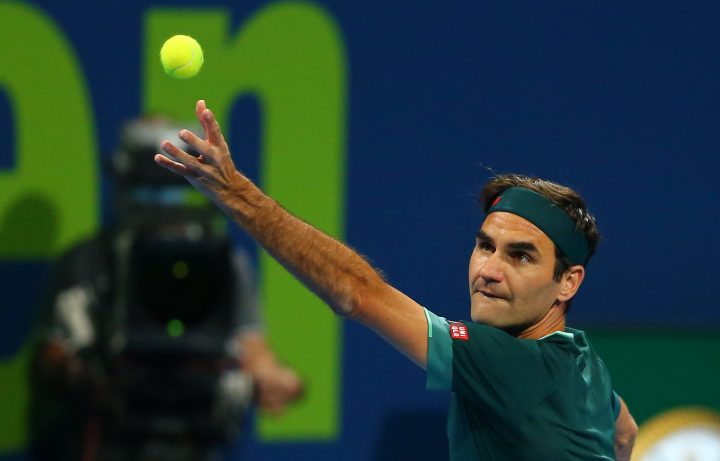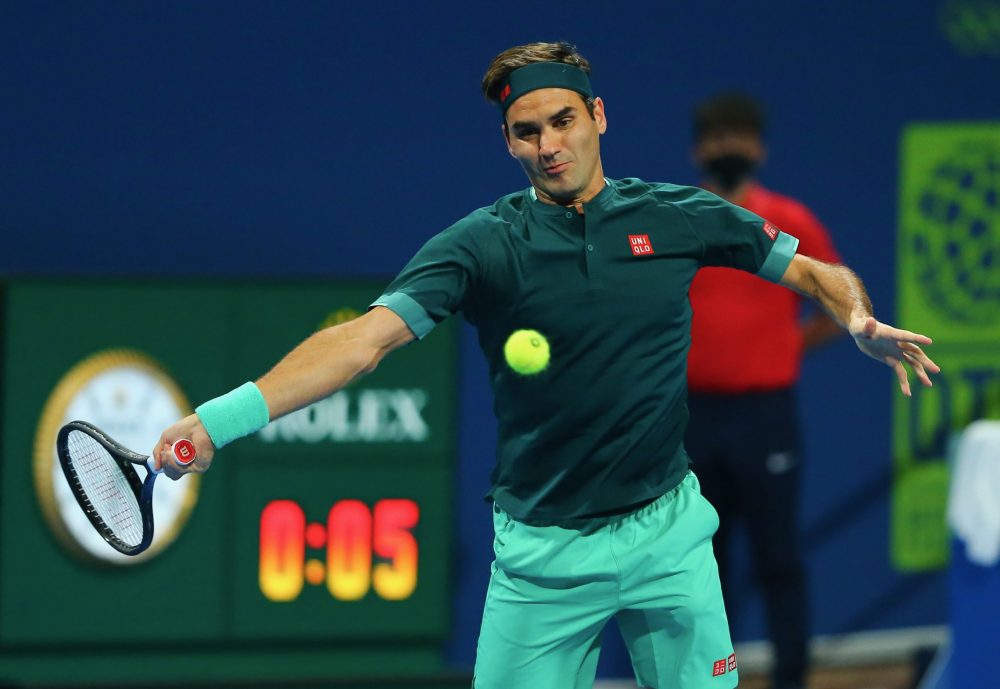Having been gone from the game for nearly 13 months after enduring two knee surgeries in 2020, Roger Federer went back to work last week in Doha as devoted tennis fans—and even the sports world at large—followed his every move. Federer, of course, is one of the most renowned athletes in the world, a singularly graceful practitioner of his craft, and an ineffably pure and artistic shotmaker who was sorely missed by his many ardent admirers.
That is why the return of the 39-year-old Swiss Maestro was eagerly anticipated by so many devoted observers across the globe. They were thirsting to see him perform again, hoping he could rekindle some of his old magic, and fascinated to find out what he could bring back to the table of competition. They wanted this version of Roger Federer to be sublime. They hoped he could inspire them once more with his sheer creativity and a soaring imagination that has long made Federer a transcendent figure in his trade.
Federer did not entirely let them down, nor did he necessarily live up to the perhaps unrealistic expectations of some fervent fans. In his opening match in the round of 16, Federer took on Great Britain’s Dan Evans, with whom he had been practicing frequently. Evans had never taken a set off Federer, but surely believed this was a golden opportunity to upset a rusty adversary who had spent 405 days away from match play.
Evans created a nice opening when he advanced to break point at 4-4 in the first set, but Federer met that moment with calm assurance. A deep inside-in forehand from Federer pulled Evans out of position, setting up the Swiss for his trademark inside-out forehand winner. Federer held on in that crucial game. On they went to a tie-break, and the 20-time major champion trailed 2-4 in that sequence and later served at 5-6 and set point down.
Federer sent a deadly accurate first serve down the middle in the ad court. Evans did not get good depth on the return. Federer stepped in and unleashed a forehand inside-out winner. Having dodged out of danger, Federer took that tie-break 10-8 on his third set point.
He was playing reasonably well, but not making much of an impression on the Evans serve. The British player claimed the second set 6-3 on one break of serve. In the final set, Federer was twice down break point at 3-3 but he released an ace and then a spectacular forehand drop shot winner.
Federer held on for 4-3 and did so again to lead 5-4. In the tenth game, Federer had a match point, but Evans caught the Swiss off guard. He came in behind a deep first serve to the backhand and put away a forehand volley unhesitatingly. That serve-and-volley combination was letter perfect. Evans stayed alive in holding for 5-5, but Federer went right back to work, holding at 30 with a dazzling backhand down the line winner, closing out the contest by breaking at 15 with another backhand down the line into the clear.

Federer’s 7-6 (8), 3-6, 7-5 triumph was hard earned. He then came back the next day to take on an entirely different type of player in Nikoloz Basilashvili. Evans had prolonged the rallies as much as possible in his duel with Federer. Basilashvili is a very big hitter who was walloping the ball with controlled aggression in this quarterfinal. Federer played a solid first set which he took comfortably before Basilashvili blitzed through the second set with a couple of service breaks, totally outhitting Federer from the baseline. On they went to a third set. At 3-3, Federer fended off three break points, erasing the first with a vicious sliced backhand drawing an error, wiping away the second with an unanswerable forehand, and casting aside the third with an excellent first serve to the backhand.
To 4-3 went Federer with a clutch hold. But Basilashvili was resolute. Serving to stay in the match in the tenth game, the Georgian was down match point, but he rescued himself admirably, approaching forcefully off a short return from Federer and keeping his shot low. Federer had no chance to make the backhand passing shot. Basilashvili held on for 5-5 and then closed out the account with some sparkling ball striking off the backhand, going down the line off that side frequently to leave Federer compromised. The world No. 42 took the last two games from 5-5, winning eight of the last eleven points, prevailing 3-6, 6-1, 7-5.
And so Federer lost narrowly in a quarterfinal contest that could have gone either way. He could be somewhat satisfied with his level of play across two close matches after a long hiatus. His smoothly efficient serve was close to normal. He had 25 aces combined in those two Doha clashes and did not serve a single double fault. All told he was quite good off the forehand. The central issue was his backhand. Federer made an alarming number of miss-hits off that side. He also bungled a swing volley or two, smiling sardonically at himself after those mistakes, knowing he could not expect perfection.
But perhaps most irksome to Federer fans was the fact that his loss to Basilashvili marked the 24th time in his illustrious career that Federer has lost a match after having at least one match point. The first time it happened for the Swiss was back in 2000. Confronting Tim Henman in the semifinals of Vienna, Federer won the first set 6-2 and had two match points with the British player serving at 5-6, 15-40 in the second set. Henman rallied to win 2-6, 7-6 (4), 6-3. Federer was only 19. No one took much notice at the time that he had not closed out that account when he was twice only a point away from prevailing.
And yet, as the years passed, these kinds of losses became surprisingly numerous for a player of his rare stature, even though on the other hand he has demonstrated over and over again that he knows what it takes to put the finishing touches on fine performances. What reasonable critic could claim that Federer was afraid to lose or incapable of closing out the most consequential of matches?
He now stands tied with Rafael Nadal for the most men’s major titles at 20, and owns 103 career singles titles, which is second only to Jimmy Connors (109) in the Open Era among the men. Furthermore, he has been a magnificent big match player, coming though in 103 of 157 overall finals for a winning percentage of .656 and taking 20 of 31 Grand Slam finals (.645).
Those numbers are excellent. But that rate of success makes these setbacks after holding match points all the more surprising. Consider this: Novak Djokovic has been beaten only three times in his entire career after advancing to match point, and yet he has struck back boldly from double match point down three times to beat Federer. Rafael Nadal has lost only eight contests when he has reached match point. The Spaniard toppled Federer in the 2006 Rome final after saving two match points in the fifth set. That was a critical win for the left-hander. Granted, both Nadal and Djokovic are much younger than Federer, but neither the Spaniard nor the Serbian has been nearly as vulnerable under these circumstances as the Swiss. Federer has played 1,515 matches across his sterling career, Nadal 1,213 and Djokovic 1,135.

Since Federer suffered that first loss to Henman after twice being at match point in 2000, there have not been many seasons when the Swiss has not experienced defeats of the same type. He managed to avoid meeting that fate in 2004, 2007, 2008, 2009, 2012 and in his abbreviated 2020 campaign. But he has lost at least one match in 16 different years after being ahead match point. In 2010, Federer lost no fewer than four battles when he had match points, which is extraordinary.
Perhaps more importantly, Federer has fallen into the unexploited match points syndrome six times across his sterling career at the majors—twice at the Australian Open (against Tommy Haas in 2002 and Marat Safin in 2005); twice at Wimbledon (versus Kevin Anderson in a 2018 quarterfinal and Novak Djokovic in the epic 2019 final), and twice at the U.S. Open (facing Djokovic in 2010 and 2011).
Most of those disappointments had large historical ramifications. Consider the 2005 Safin loss in the semifinals of Melbourne. Federer was ahead two sets to one, and reached match point at 6-5 in the fourth set tie-break. He served-and-volleyed on his second delivery. Federer lunged to make a decent backhand first volley down the line. Safin’s passing shot was low, and Federer responded with a short backhand finesse volley. Safin scampered forward swiftly and lofted a perfect lob down the middle over Federer’s head. Federer chased it down but, rather than answer with a lob of his own, he went for a “tweener” and missed it badly. Federer has always had a knack for when to play the percentages and when to be audacious, but his split-second judgement in this instance was misguided.
Be that as it may, a buoyant Safin won the next two points to seal the fourth set and then took the hard fought fifth, toppling Federer 5-7, 6-4, 5-7, 7-6 (6), 9-7 in four hours and 28 minutes. Federer won 201 points in that match to Safin’s 194, but still lost. He had beaten Safin in the final of the Australian Open the year before, and had a 6-1 career winning record over the Russian going into this confrontation. Federer would finish 10-2 over Safin.
But that critical semifinal in Melbourne got away from the Swiss. He would have played Lleyton Hewitt in the final. Federer had beaten Hewitt six consecutive times in 2004, including a round of 16 win at the Australian Open and a crushing 6-0, 7-6 (3), 6-0 victory in the U.S. Open final. So his defeat against Safin was immensely consequential. Federer would have been highly unlikely to lose against Hewitt in the final. That Australian Open would have surely belonged to him.
But while that misfortune against Safin was significant, think of the three stunning reversals of fortune between Djokovic and Federer at the premier events. At the 2010 U.S. Open, Djokovic was serving at 4-5, 15-40 against Federer in the semifinals, but he courageously produced a forehand swing volley winner off a hanging Federer sliced backhand. On the second match point, Djokovic laced a forehand inside-in winner. Djokovic held on for 5-5 and then completed a stunning 5-7, 6-1, 5-7, 6-2, 7-5 victory.
On to 2011. Federer and Djokovic clashed in the penultimate round of the U.S. Open for the fourth year in a row after Federer had overcome the Serbian in the 2007 final. Djokovic rallied from two sets to love down to force a fifth set. But the Swiss was revitalized, serving for the match at 5-3, 40-15. For the second straight year, Federer had fashioned a double match point lead in the U.S. Open semifinals against Djokovic.
But history repeated itself. Federer swung a slice serve wide in the deuce court. Djokovic went for broke, lacing a screaming forehand return winner crosscourt. It was the “shot heard around the world.” At 40-30, Federer hit a fine body serve but Djokovic fought it off, and his backhand return coaxed Federer into a forehand error.
Djokovic swept four games in a row to finish off an astonishing 4-6 6-7 (7), 6-3, 6-2, 7-5 victory. For the second consecutive year, he had rallied from double match point down to upend Roger Federer in New York. In both of those years, Rafael Nadal made it to the final. Had Federer moved past Djokovic on either occasion, Nadal at that time would have been the favorite to beat him for the crown, but who knows for certain what might have happened?
Let’s move on to 2019 at Wimbledon. Djokovic and Federer were colliding in their third Centre Court final, with the Serbian having ousted the Swiss in 2014 and 2015. It was the signature match of their astounding career head to head series, which Djokovic now leads 27-23. Djokovic trailed 5-3 in the first set tie-break but collected four points in a row to salvage it. Federer blazed through the second set before Djokovic battled back from set point down late in the third set to win another tie-break.
Federer stormed back again to send the battle into a fifth set. Djokovic led 4-2 but Federer rallied to 4-4. The Swiss broke Djokovic again in the 15th game and served for the match at 8-7, reaching 40-15 with consecutive aces.
For the third time in his career at a major, Roger Federer would lose to Novak Djokovic improbably after arriving at double match point. On the first match point, he steered a shaky forehand wide. Then Djokovic saved the second with a clutch forehand crosscourt passing shot winner. He soon broke back for 8-8, leaving the overwhelmingly pro-Federer Centre Court audience in quiet despair.
In the end, this classic encounter was settled in the first ever fifth set tie-break at Wimbledon in men’s singles, with Djokovic cooly outplaying his formidable rival to complete a 7-6 (5), 1-6, 7-6 (4), 4-6, 13-12 (3) victory. Federer has never beaten both Nadal and Federer in the same Grand Slam tournament, and would have collected a 21st major title by realizing that extraordinary feat for the first time. Instead, Djokovic took his 16th “Big Four” crown. It was surely the most gratifying victory of Djokovic’s career and the most devastatingly potent defeat ever for Federer.
So there you have it. The “match point syndrome” has haunted Federer more times than he would care to remember. But it must be said that he has made more than his share of gallant comebacks. On 22 occasions in his career, he has rallied from at least one match point down to win, which is no mean feat. That list of triumphs includes four wins at the majors— two at the U.S. Open, one at Wimbledon and one at the Australian Open.
None of those four comebacks at the majors led to Federer capturing the titles. Nonetheless, some of his other match point recoveries did indeed result in Federer becoming the champion, most recently his 2017 Miami quarterfinal rescue mission against Tomas Berdych, when he saved two match points and went on to oust Nadal in the final. At five other tournaments when he saved match points along the way, Federer also took the title, including round robin triumphs at the ATP Finals against Andre Agassi in 2003 and Andy Roddick three years later as Federer moved on to win those prestigious tournaments.
Leaving the match point setbacks and recoveries aside, where does Federer go from here? It is not easy to project. I thought he would compete in Dubai this week since he only played two matches in Doha, but Federer felt he had to resume his training. No one can gauge the current state of Roger Federer and his game better than Federer himself. But he surely needs many more matches if he is going to make a serious bid for a ninth Wimbledon title in July.
He had already decided to skip Miami, and so, between now and the start of the grass court season in June, he can only compete in clay court events. There will be some tough scheduling decisions ahead. I don’t think he really believes he can win a second French Open title this year, so will he go to Paris? Perhaps he will; in 2019 he chose to return to Roland Garros for the first time in four years, reaching the semifinals before nearly winning Wimbledon.
The view here is that Wimbledon will be his last best chance to secure a 21st major crown. He will be 40 in August. He has not won the U.S. Open since he took his fifth consecutive title there in 2008. That is why he will surely throw all of his emotional energy into winning Wimbledon this year. Even if Federer rounds into top form, it will still be awfully tough yet not impossible for him to rule again at the All England Club. But the fact remains that he is never going to sell himself short. All of us must remember that he is a champion through and through with a seemingly limitless supply of ambition and a propensity to put his greatest wins and most bruising defeats behind him, simply pressing on professionally to pursue his immediate goals.
Steve Flink has been reporting full time on tennis since 1974, when he went to work for World Tennis Magazine. He stayed at that publication until 1991. He wrote for Tennis Week Magazine from 1992-2007, and has been a columnist for tennis.com and tennischannel.com for the past 14 years. Flink has written four books on tennis including “Dennis Ralston’s Tennis Workbook” in 1987; “The Greatest Tennis Matches of the Twentieth Century” in 1999; “The Greatest Tennis Matches of All Time” in 2012; and “Pete Sampras: Greatness Revisited”. The Sampras book was released in September of 2020 and can be purchased on Amazon.com. Flink was inducted into the International Tennis Hall of Fame in 2017.






